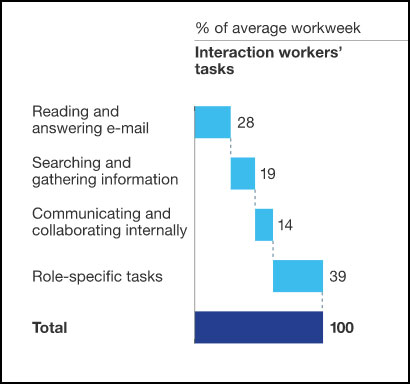In mid-sized and large companies, creating an environment that facilitates collaboration can be difficult. Often you’ll find that departments have sectioned themselves off, rarely communicating with outside departments. To facilitate communication, companies need to create a company communication plan. An engaged and collaborative company must push for collaboration and engagement between departments.
According to a Gallup study, only 30% of employees are engaged at work. Much of that lack of engagement can be attributed to a lack of communication and valuable relationships in the workplace. When employees are able to sit in their cubicle and complete their work without seeking outside feedback, it makes it difficult to become truly engaged.

Source: McKinsey
Fostering communication and improving engagement within a company starts with giving your employees the resources that they need to find information and make decisions. All companies should create and disseminate a company communication plan that includes an organizational chart for reference. This can’t be better demonstrated than it was in a recent report from McKinsey, who found that the average worker spends 28 percent of their work week managing email, and nearly 20 percent of their time looking for information and tracking down colleagues to help.
There are multiple strategies that can help to improve engagement and give employees the tools that they need to collaborate effectively. Installing interactive communication channels like Slack can be helpful. As can opening the lines of communication with an internal social media platform. However, a recent report from Prescient Digital Media shows that employees often avoid interacting through a company’s intranet. The results showed that just 13 percent of employees use their company intranet on a daily basis, while 31 percent stated that they never do.
So how do you solve this issue? You could mandate that employees use your company intranet — but most will only use it when a task requires it, or will participate the minimum amount to meet requirements. Forced engagement doesn’t solve the issue.
Instead of complicating the situation, companies should look to simplify. Many companies overlook the importance of making an organizational chart available to their own teams. Organizational charts provide insight into the structure of the company, improve lines of communication, and help employees build valuable relationships.
There are a few key ways in which an org chart can specifically help to improve communication and engagement:
Remove the Guesswork in Making Connections

The McKinsey report we mentioned earlier stated that employees spend nearly 20 percent of their time looking for information and tracking down colleagues and information related to a specific task. Much of this time is spent playing email-tag with a handful of people just to figure out who they should really be getting in contact with. That’s a lot of time!
An organizational chart is a simple solution to this costly problem. Giving your employees the ability to see the structure of different departments can take a lot of the guesswork out of figuring out who to contact about a specific issue. In a company of hundreds of people, figuring out who is overseeing a specific task can be almost impossible.
When your teams have access to an org chart, they can more easily identify who would oversee a specific issue. Even if they can’t discern the right person right away, they can reach out to the appropriate manager to be pointed in the right direction. Org charts can reduce a lot of the unnecessary back-and-forth that comes with information hunting.
Improve Organizational Understanding in New Hires

We’ve all been the “new guy” (or gal) at some point. It can be daunting to assume a new role without an understanding of who you should talk to about specific issues. Often, after training ends, new hires are thrown to the wolves without knowing how the company operates.
The lack of a comprehensive onboarding process plays a huge role in the 50% failure rate within 120 days for hourly new hires. These first few months couldn’t be more crucial to the onboarding process, as new hires typically decide whether they will stay with a company during their first six months of employment. It also happens to be the time frame when new employees need to reach out to others to find information, despite having a limited understanding of the organizational structure.
An organizational chart is a simple but effective way to improve the new hire onboarding process. It gives them a top-down view of the structure of the company, helping them to identify who to speak with when they have specific questions. Perhaps most importantly, it can push new hires toward interacting with people from other departments. Facilitating these relationships early in their employment is crucial for long-term engagement. A recent Gallup Study shows that an effective onboarding process sets expectations and facilitates alignment, which directly correlates with increased engagement.
Enhance Coordination Between Departments

What most companies fail to see is that their employees actually crave collaboration. They see the stats like the ones we’ve shared in this article and chalk it up to human nature. They assume that people like to be left alone to do their work with minimum interruptions. In actuality, that couldn’t be further from the truth.
Nearly 40% of employees state that the people within their company do not collaborate enough, according to a study from Queen’s University. But they not only want more communication — they need it to do their jobs. In a survey conducted by the Computing Technology Industry Association, 28 percent reported poor communication as the primary cause of failing to deliver a project by its original deadline.
A lack of interdepartmental communication can often be blamed on a lack of knowledge. When you don’t often interact with a specific team, you won’t know which members of the team to contact. You haven’t built those personal relationships and reaching out may feel bothersome or unnecessary. Providing your employees with an org chart can help to build relationships, improve coordination, and help projects complete on-time.
How Organimi Can Help Your Company Communication Plan
Organimi not only makes the creation of organizational charts simple, our platform also makes it easy to keep your chart updated. Although there may be reasons to limit the distribution of your complete org chart, having a regularly updated version of your org chart available to your departments and teams can help to reduce time spent searching for information and improve engagement among employees.
In some companies, an employee’s daily duties will rarely require that they interact with people in other departments. Then when a project requires collaboration, they won’t have the familiarity and relationships built that lead to success. An org chart should be a vital piece of any company communication plan. By providing an org chart, you can ensure that all employees have a firm understanding of your organizational structure. This allows them to make more accurate decisions when searching for information and helps all employees (especially new hires) build relationships that are vital in early employment.

